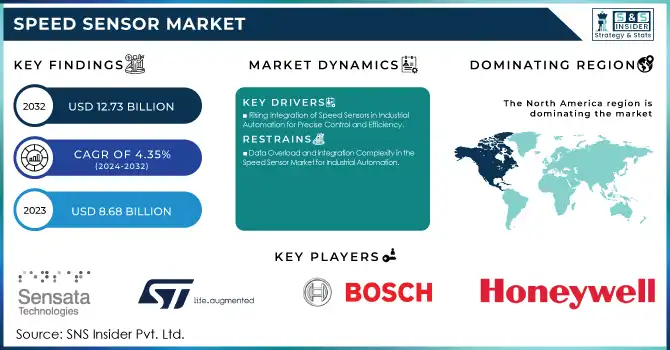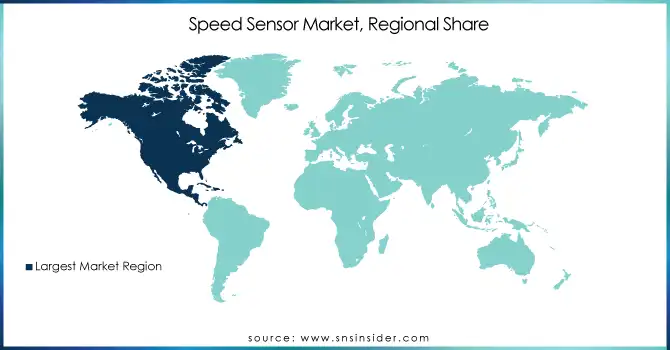Speed Sensor Market Key Insights
The Speed Sensor Market Size was valued at USD 8.68 Billion in 2023 and is expected to reach USD 12.73 Billion by 2032 and grow at a CAGR of 4.35% over the forecast period 2024-2032.

Get more information on Speed Sensor Market - Request Sample Report
The Speed Sensor Market is experiencing significant growth, driven by the rising demand for fuel efficiency across the automotive and transportation sectors. Global automotive manufacturers are increasingly focusing on enhancing vehicle performance and optimizing fuel consumption. This trend is especially prominent with the rise of electric vehicles (EVs) and autonomous vehicles, which require precise speed measurement technologies. As these markets grow, the need for speed sensors, particularly Hall-effect sensors, has skyrocketed. These sensors play a crucial role in ensuring accurate speed measurement, which directly contributes to fuel optimization and carbon emission reduction, aligning with global sustainability goals.
The transportation industry is undergoing a transformation, with a shift toward fuel-efficient logistics and smarter trucking technologies. This shift has been driven by regulatory pressures and increasing fuel costs, making the adoption of fuel efficiency sensors, including speed sensors, crucial for optimizing fuel usage. Reports indicate that reducing vehicle speed can lead to a 27% improvement in fuel efficiency. Trucks traveling at 60-65 mph (the sweet spot for fuel economy) consume significantly less fuel compared to those traveling at higher speeds. Additionally, fleet operators can improve fuel economy by up to 25% by optimizing driver behavior, as shown in studies comparing the worst and best drivers.
In North America, the trucking industry faces stricter fuel economy standards aiming to reduce fuel consumption, with Class 8 trucks projected to represent 26% of all transportation fuel consumption. This makes speed sensors a key component in meeting regulatory requirements and improving the overall efficiency of heavy-duty vehicles. Furthermore, the growing demand for precision in aerospace and industrial automation applications is also contributing to the increased adoption of speed sensors across diverse industries.
Speed Sensor Market Dynamics
Drivers
-
Rising Integration of Speed Sensors in Industrial Automation for Precise Control and Efficiency
The growing adoption of industrial automation is a significant driver for the speed sensor market, as these sensors play a critical role in enhancing the precision, efficiency, and safety of industrial machinery and equipment. As industries shift towards automated systems to increase production efficiency and reduce operational costs, the demand for high-precision sensors like speed sensors is surging. In manufacturing plants, motion control and automated machinery rely heavily on speed sensors to ensure the accurate and optimal functioning of motors, conveyor belts, and robotic arms. by providing real-time data on rotational speed, these sensors help prevent equipment malfunctions, reduce downtime, and maintain consistent production quality. The use of speed sensors in automated material handling systems and robotic operations helps to streamline processes, improving throughput and reducing human error. Smart factories, which are becoming more prevalent in the industrial sector, leverage sensor technology for advanced predictive maintenance and process optimization. This reduces the need for manual intervention, enhancing both the reliability and longevity of industrial equipment. The digitalization of industrial processes, as highlighted by leaders like Sandvik and EPIQ Machinery, has further accelerated the demand for sophisticated sensors. As industrial automation continues to expand, the ability to monitor and control speed will become even more essential, making speed sensors an integral part of the industrial IoT ecosystem. This growing integration of sensors in automated systems is expected to drive the market for speed sensors, further fueling innovation and technological advancements in the field.
Restraints
-
Data Overload and Integration Complexity in the Speed Sensor Market for Industrial Automation
The rapid adoption of IoT devices in industrial automation has led to a surge in data generation from speed sensors and other monitoring systems. As sensors provide real-time feedback on machine performance, vibration, and motion, the sheer volume of data can overwhelm organizations without the necessary data analytics capabilities. This data overload poses a significant challenge in efficiently processing and analyzing sensor data to derive actionable insights, particularly for companies with limited IT infrastructure or expertise. Integrating these vast data streams from multiple sensors across different systems can lead to integration complexity, hindering smooth data flow and decision-making processes. As companies continue to scale automation, the ability to manage, store, and analyze massive datasets becomes increasingly critical, but the technical and financial costs of data integration remain high. The need for sensor fusion combining data from different sensor types to enhance data accuracy and perception is one method to address this challenge. However, integrating multi-sensor data often requires advanced data processing algorithms and edge computing capabilities, which may not be readily available for all industrial players. The complexity of ensuring data interoperability across multiple platforms and devices increases the risk of system errors or data inconsistencies. As industries strive for smart factories, overcoming the barriers of data overload and integration complexity remains a major hurdle, potentially slowing the widespread adoption of speed sensors in industrial automation.
Speed Sensor Market Segment Overview
by Type
In 2023, the Magnetoresistive (MR) segment is dominating the speed sensor market, accounting for approximately 54% of the total market share. Magnetoresistive sensors are preferred for their high accuracy, sensitivity, and robust performance in detecting speed and motion, especially in harsh industrial environments. These sensors utilize the principle of magnetoresistance, where the resistance of the sensor changes in response to the magnetic field, making them ideal for precise speed measurement. MR sensors offer advantages over traditional technologies, including low power consumption, compact size, and resilience to temperature fluctuations, which makes them highly effective in applications such as automotive, robotics, and industrial machinery. Their ability to operate in diverse environments and deliver reliable data continues to drive the growth of this segment in the speed sensor market.
by Application
In 2023, the automotive segment is leading the speed sensor market, capturing around 49% of the total market share. The widespread adoption of speed sensors in the automotive industry is driven by the increasing demand for advanced driver-assistance systems (ADAS), vehicle safety features, and autonomous driving technologies. Speed sensors play a crucial role in monitoring vehicle speed, wheel rotation, and transmission systems, enhancing vehicle performance, fuel efficiency, and safety. Their integration into anti-lock braking systems (ABS), traction control systems (TCS), and electronic stability control (ESC) further supports their dominance. Additionally, the growth in electric vehicles (EVs) and connected vehicles contributes to the rising demand for speed sensors in the automotive sector.
Speed Sensor Market Regional Analysis
North America is set to be the fastest-growing region in the speed sensor market from 2024 to 2032. The growth is driven by strong demand from the automotive industry, particularly with the rise of electric vehicles (EVs), autonomous vehicles, and advanced driver-assistance systems (ADAS), which rely heavily on precise speed sensors. Additionally, the region's focus on automation in industrial applications, such as manufacturing and robotics, is further propelling the market. The presence of key players in the United States and Canada, along with government initiatives supporting smart cities and IoT development, also contributes to the market's expansion. With technological advancements and increased investments in R&D, North America is expected to maintain its rapid growth in the coming years.

Get Customized Report as per your Business Requirement - Request For Customized Report
Key Players
Some of the major key Players in Speed sensor Market with their product:
-
Honeywell International Inc. (Speed Sensors for automotive, industrial, and aerospace applications)
-
Robert Bosch GmbH (Wheel Speed Sensors, Engine Speed Sensors)
-
STMicroelectronics (Speed Sensors for automotive and industrial applications)
-
Sensata Technologies, Inc. (Magnetic Speed Sensors, Hall Effect Sensors)
-
DENSO Corporation (Automotive Speed Sensors)
-
Continental AG (Wheel Speed Sensors, Engine Speed Sensors)
-
Texas Instruments (Magnetic Speed Sensors, Automotive Sensors)
-
Analog Devices, Inc. (High-precision Speed Sensors for automotive and industrial)
-
Bourns, Inc. (Rotary Speed Sensors, Linear Speed Sensors)
-
Delphi Technologies (Automotive Speed Sensors)
-
Renesas Electronics Corporation (Speed Sensors for automotive and industrial applications)
-
Aptiv PLC (Automotive Speed Sensors, Electric Vehicle Speed Sensors)
-
TE Connectivity (Magnetic Speed Sensors, Industrial Speed Sensors)
-
Honeywell Sensing and Control (Speed Sensors for Industrial Applications)
-
Infineon Technologies AG (Magnetic and Hall Effect Speed Sensors for automotive applications)
-
NXP Semiconductors (Automotive Speed Sensors, Hall Effect Sensors)
-
Microchip Technology Inc. (Speed Sensors for automotive and industrial applications)
-
Toshiba Corporation (Speed Sensors for automotive, industrial, and consumer electronics)
-
Vishay Intertechnology Inc. (Hall Effect Speed Sensors, Automotive Sensors)
-
Broadcom Inc. (Magnetic Speed Sensors, Automotive Speed Sensors)
List of 20 key suppliers for raw materials and components used in the manufacturing of speed sensors:
-
3M Company
-
Honeywell International Inc.
-
Ametek, Inc.
-
Littelfuse, Inc.
-
Vishay Intertechnology Inc.
-
TDK Corporation
-
Murata Manufacturing Co., Ltd.
-
NXP Semiconductors
-
STMicroelectronics
-
Infineon Technologies AG
-
Texas Instruments
-
Maxim Integrated
-
Analog Devices, Inc.
-
Vero Technologies
-
Yageo Corporation
-
Schneider Electric
-
TE Connectivity
-
Aptiv PLC
-
Broadcom Inc.
-
Rohm Semiconductor
Recent Development
-
April 29, 2024: Honeywell has been selected by Lilium to supply innovative propulsion unit position sensors for the Lilium Jet, the world’s first eVTOL jet. These resolvers are designed to accurately sense the engine’s position, ensuring precise takeoff and safe flight operations for the jet.
-
January 11, 2024: The Big Sky Camera System utilizes an 18K STMicroelectronics sensor to deliver exceptional image detail and fidelity for the Sphere Experience, featuring a 316-megapixel sensor crucial for the Sphere’s massive display quality.
-
December 13, 2024: Continental will showcase its "Intelligent Vehicle Experience Car" at CES 2025, featuring biometric solutions for seamless vehicle access. This innovation aligns with speed sensor technology, which ensures precise speed monitoring and enhances the vehicle's smart, secure, and efficient interaction with users.
| Report Attributes | Details |
|---|---|
| Market Size in 2023 | USD 8.68 Billion |
| Market Size by 2032 | USD 12.73 Billion |
| CAGR | CAGR of 4.35% From 2024 to 2032 |
| Base Year | 2023 |
| Forecast Period | 2024-2032 |
| Historical Data | 2020-2022 |
| Report Scope & Coverage | Market Size, Segments Analysis, Competitive Landscape, Regional Analysis, DROC & SWOT Analysis, Forecast Outlook |
| Key Segments | • By Type (Hall Effect, Magneto Resistive, Variable Reluctance) • By Application (Automotive, Industrial, Aerospace & Defense, Consumer Electronics) |
| Regional Analysis/Coverage | North America (US, Canada, Mexico), Europe (Eastern Europe [Poland, Romania, Hungary, Turkey, Rest of Eastern Europe] Western Europe] Germany, France, UK, Italy, Spain, Netherlands, Switzerland, Austria, Rest of Western Europe]), Asia Pacific (China, India, Japan, South Korea, Vietnam, Singapore, Australia, Rest of Asia Pacific), Middle East & Africa (Middle East [UAE, Egypt, Saudi Arabia, Qatar, Rest of Middle East], Africa [Nigeria, South Africa, Rest of Africa], Latin America (Brazil, Argentina, Colombia, Rest of Latin America) |
| Company Profiles | Honeywell International Inc., Robert Bosch GmbH, STMicroelectronics, Sensata Technologies, Inc., DENSO Corporation, Continental AG, Texas Instruments, Analog Devices, Inc., Bourns, Inc., Delphi Technologies, Renesas Electronics Corporation, Aptiv PLC, TE Connectivity, Honeywell Sensing and Control, Infineon Technologies AG, NXP Semiconductors, Microchip Technology Inc., Toshiba Corporation, Vishay Intertechnology Inc., Broadcom Inc. |
| Key Drivers | • Rising Integration of Speed Sensors in Industrial Automation for Precise Control and Efficiency. |
| Restraints | • Data Overload and Integration Complexity in the Speed Sensor Market for Industrial Automation. |

